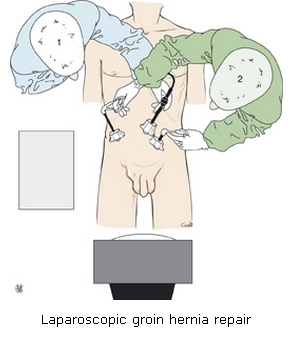LAPAROSCOPIC GROIN HERNIA REPAIR
The laparoscopic approach to groin hernia repair represents an immense progress in terms of hernia recurrence rates, patient comfort and work leave. Feared techniques of the past have given way to an operation that can truly be considered benign.
I have been using this minimally invasive technique for the last 20 years and have gained a wide personal experience of over 3000 procedures.
This operation features :
- day surgery or overnight stay
- low pain and physical disability
- work leave 1-2 weeks
- strenuous physical exercise allowed after only 2 weeks
- low 0.5% recurrence rate
How is surgery performed ?
The patient enters hospital the same day or the evening before the operation. The lower abdomen is shaved and the patient empties his bladder before going to surgery. The procedure is performed under general anesthesia, takes 45 minutes and is done using three small midline skin incision (5,5 and 10mm) below the navel. They are entry points for the camera system, instruments and the rolled-up mesh.
The hernia contents are repositioned within the abdomen and the mesh is unrolled and positioned to cover the hernia defect. At the end of the operation the mesh is imprisoned between layers of the abdominal wall and usually does not require fixation. Most often the patient is discharged on the same evening. Pain, although variable, is usually moderate and patients are instructed to take 3-4 grammes per day of paracetamol if required. Non-steroidal anti-inflammatory drugs (Brufen,Nurofen,Diclofenac) can be added in case of shoulder pain. Waterproof wound dressings are applied before discharge allowing showers to be taken. They can be left untouched until the office visit the following week. Normal physical activity is allowed immediately. Strenuous physical exercise and sports are to be avoided for a period of 2 weeks.

Source : M Beck Traitement coelioscopique des hernies inguinales de l’adulte par voie totalement extrapéritonéale.
EMC-Techniques chirurgicales-Appareil digestif 2014 ;9(1) :1-12 (Article 40-137-A)
What to expect in the days following surgery ?
- Abdominal bloating for 2 weeks
- Wound induration lasting for several months
Frequent post-operative signs that are not worrisome :
- Shoulder pain for several days due to abdominal gas
- Bruise on the genitals (disappears after 10 days)
- Painless hard lump at the site of the hernia that cannot be pushed back in. This is not a recurrence but just fluid that disappears within 2 months and if not can be evacuated at an office visit.
- Mild skin sensitivity of the scrotum lasting 1 month
- Rare transient groin pain
Costs of medical devices
These charges cover the disposables (trocars, scissors) and mesh. In conformity with Belgian legislation part of these costs are covered by social security and the remaining 325 € is charged to the patient. If you have private insurance this amount will be covered by your insurance.
Dr Serge Landen - www.drlanden.be